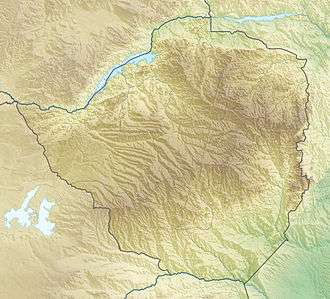Batoka Gorge Hydroelectric Power Station
The proposed Batoka Gorge Hydroelectric Power Station is a 2,400 megawatts (3,200,000 hp) hydroelectric power station, planned to be on the Zambezi River across the International border between Zambia and Zimbabwe.[1]
| Batoka Gorge Dam | |
|---|---|
 Location of Batoka Gorge Dam in Zimbabwe | |
| Country | Zambia/Zimbabwe |
| Coordinates | 17°55′11″S 26°07′51″E |
| Purpose | Power |
| Status | Proposed |
| Dam and spillways | |
| Type of dam | Arch gravity |
| Impounds | Zambezi River |
| Height | 181 m (594 ft) |
| Width (crest) | 12 m (39 ft) |
| Width (base) | 97.8 m (321 ft) |
| Spillway capacity | 20,000 m3/s (710,000 cu ft/s) |
| Reservoir | |
| Total capacity | 1,680×106 m3 (1,360,000 acre⋅ft) |
| Catchment area | 508,000 km2 (196,000 sq mi) |
| Turbines | 12 x 200 megawatts (270,000 hp) Francis-type |
| Installed capacity | 2,400 megawatts (3,200,000 hp) |
Location
The proposed power station will be located on the Zambezi River, approximately 54 kilometres (34 mi), downstream of Victoria Falls, straddling the international border between Zambia and Zimbabwe.[2]
Overview
Currently, the proposal is for two power plants, each with an installed capacity of 1,200 megawatts (1,600,000 hp); one on the Zambian side and another on the Zimbabwean side. The dam to supply the reservoir with water will be a 181 metres (594 ft) tall arch-gravity type.[3]
The project is being implemented by the Zambezi River Authority, a bi-national organisation mandated to operate, monitor and maintain the Kariba Dam Complex as well as exploit the full potential of the Zambezi River.[4]
Community Resistance
Like in the proposal in the 1990s that was stopped, and now again, stakeholders and the local community are strongly opposed to the dam's construction. The tourism industry generated by the current Batoka Gorge, including its whitewater rafting, employs thousands of local individuals both directly and indirectly, and has been acknowledged as the 3rd largest contributor to Zambia's economy.[5] While destroying the tourism industry, the dam will also not accomplish its desired effect and not provide electricity to the rural, local population, as it will be exported to the Southern African Power Pool.[6]
Other than the economy, the local community is also concerned about the environment. According to the January 26, 2015 article published in Zambesia, the dam could cause the river to back-up to within 650 meters of the Victoria Falls, a UNESCO World Heritage Site.[7] Contrary to the UNESCO World Heritage Site restrictions, this would be a direct violation of the agreed-upon 12 km boundary preservation below the Falls.[8] Consequently, both Zimbabwe and Zambia would be in direct violation of their international legal obligations pursuant to the Convention Concerning the Protection of the World Cultural and Natural Heritage (Adopted by the General Conference at its seventeenth session (Paris, 16 November 1972)).[9] In other words, if the dam proposal moves forward, the deleterious effect is tantamount to the Victoria Falls becoming a "World Heritage in Danger".[10]
Construction costs
As of July 2018, the projected cost of development was estimated at US$4.5 billion. General Electric Africa has expressed interest in developing this power station under the design-build-operate-transfer arrangement, but with ownership reverting to Zambia and Zimbabwe, after the developers have recovered their investment (with profits).[4]
In June 2019, Bloomberg News reported that the construction contract had been awarded to a consortium comprising General Electric of the United States and Power Construction Corporation of China.[1]
References
- Matthew Hill, and Prinesha Naidoo (21 June 2019). "GE, PowerChina Set to Build $4 Billion Zambia-Zimbabwe Plant". Bloomberg.com. Retrieved 22 June 2019.
- Lusaka Times Staff (27 September 2013). "Construction of Dam for Batoka Gorge hydroelectric power stations to start next year". Lusaka Times. Lusaka. Retrieved 10 July 2018.
- COMESA (7 March 2014). "Batoka Gorge Hydro-Power Project Profile" (PDF). Common Market for Eastern and Southern Africa (COMESA). Archived from the original (Archived from the Original) on 7 March 2014. Retrieved 9 July 2018.
- Mukarati, Levi (9 July 2018). "$4.5 Billion Batoka Deal to Create 6,000 Jobs". The Zimbabwe Herald. Harare. Retrieved 10 July 2018.
- "The Zambezi River: Threatened Paddling Classics #7". Canoe & Kayak Magazine. 2015-03-10. Retrieved 2017-04-12.
- Canoe & Kayak Magazine (10 March 2015). "The Zambezi River: Threatened Paddling Classics #7". Canoe & Kayak Magazine. Retrieved 12 April 2017.
- "Latest Update on the Batoka Dam Project | VictoriaFalls24". victoriafalls24.com. Retrieved 2017-04-12.
- Centre, UNESCO World Heritage. "Mosi-oa-Tunya / Victoria Falls". whc.unesco.org. Retrieved 2017-04-12.
- Centre, UNESCO World Heritage. "Convention Concerning the Protection of the World Cultural and Natural Heritage". whc.unesco.org. Retrieved 2017-04-12.
- Centre, UNESCO World Heritage. "World Heritage in Danger". whc.unesco.org. Retrieved 2017-04-12.